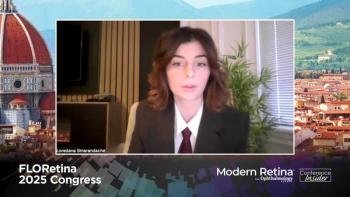
- Ophthalmology Times Europe April 2023
- Volume 19
- Issue 03
New approach to foveal holes: Light, sound and nutraceuticals
Novel treatment results in macular hole closure.
The combined administration of light and sound with nutraceuticals to the retina of a patient with a macular hole had a remarkable effect on the retinal anatomic architecture affected by the macular hole, according to Dr Roberto Pinelli, founder of the Switzerland Eye Research Institute in Lugano, Switzerland.
Case report
A 79-year-old healthy woman presented for an eye examination in January 2021, when she received a diagnosis of an idiopathic macular hole. At diagnosis, the uncorrected decimal visual acuity (VA) was 1/10 and the best-corrected VA was 4/10. At the diagnosis, the patient had a slight central metamorphopsia. The idiopathic macular hole was caused by vitreal degeneration with traction on the fovea.
Following a detailed explanation, she consented to a noninvasive treatment with pulsatile stimulation with sound and light (photobiomodulation) with oral intake of phytochemicals.
During and after treatment, she received follow-up using optical coherence tomography (OCT) imaging to assess the time course of the volume and integrity of the surrounding or inner tissue replacement of the macular hole. Retinal topography calculated the thickness of the various retinal layers and the empty area in the hole. She also underwent subjective visual tests, including the Jaeger chart test and Snellen chart test to measure the best-corrected VA for near and far, the Amsler grid test to detect visual distortion and the Pelli-Robson chart test to measure contrast sensitivity, he said.
While reclining on a chair, the patient underwent a session of low-sound, near-infrasound frequency acoustic stimulation consisting of soundwaves in a range between 20 and 174 MHz, which were applied at progressively increasing frequency up to 174 MHz, at which point the stimulation was continued and the frequency remained steady. The sound stimulation periods lasted 90 seconds.
The periodic stimulations were repeated during the same day, that is to say, ie, 7 periods of acoustic stimulation delivered at 30-second intervals with intervals of acoustic silence, for a total duration of 15 minutes. The subjective intensity (decibels [dB]) of the acoustic stimulus depended on the frequency and was delivered at between 20 and 30 dB through commercial Beats headphones. Two months after the end of the acoustic stimulation, OCT was carried out along and the VA measured.
Dr Pinelli explained that because partial results were obtained with sound stimulation, he added photobiomodulation in the same single session and added phytochemicals, which were administered for 6 months, as natural nutraceutical waves.1
The anatomic recovery was almost complete at about 1 year after the diagnosis and the beginning of treatment. The structural healing of the macular hole was concomitant with a strong VA improvement and resolution of the metamorphopsia.
Treatment rationale
Dr Pinelli explained that there is evidence that specific wavelengths activate the autophagy pathway in the retina, prompting the recovery from traumatic neuronal damage.
He said, “Among numerous biochemical cascades that regulate neuronal integrity in the retina, the autophagy machinery plays a seminal role in maintaining cell survival and sustaining retinal anatomy, including plasticity. This is in line with the involvement of impaired autophagy in producing a variety of retinal disorders.”2-4
In this report, he capitalised on those effects that elicit autophagy using light therapy with autophagy-activating phytochemicals to address the foveal damage produced by the vitreal mechanical traction that generated the foveal hole.
“The study was implemented by pulsatile sound stimulation based on the recent evidence that autophagy and retinal stem cells stimulation induced by light exposure is amplified by acoustic biofeedback therapy. In fact, the pulses of sounds of various wavelengths stimulate tissue regeneration.5-7 Such an effect is largely grounded on the stimulation of stem cell via upregulation of autophagy.8 Altogether this evidence tempted us to probe the efficacy of a non-invasive multimodal physicochemical approach to promote substance recovery and anatomical reorganisation in a case of idiopathic macular hole which was treated according to the advanced Lugano protocol,” he commented.
Roberto Pinelli, MD
e: [email protected]
Roberto Pinelli, MD, is founder of the Switzerland Eye Research Institute in Lugano, Switzerland.
References
1. Pinelli R, Berti C, Scaffidi E, et al. Combined pulses of light and sound in the retina with nutraceuticals may enhance the recovery of foveal holes. Arch Ital Biol. 2022;160(1-2):1-19. doi:10.12871/000398292022121
2. Pinelli R, Bertelli M, Scaffidi E, et al. Nutraceuticals for dry age-related macular degeneration: a case report based on novel pathogenic and morphological insights. Arch Ital Biol. 2020;158(1):24-34. doi:10.12871/00039829202013
3. Pinelli R, Bertelli M, Scaffidi E. The first clinical case of dry age-related macular degeneration treated with photobiomodulation and nutraceuticals: a protocol proposal. CellR4. 2020;8:e2833.
4. Intartaglia D, Giamundo G, Conte I. Autophagy in the retinal pigment epithelium: a new vision and future challenges. FEBS J. 2022;289(22):7199-7212. doi:10.1111/febs.16018
5. Foglietta F, Canaparo R, Francovich A, et al. Sonodynamic treatment as an innovative bimodal anticancer approach: shock wave-mediated tumor growth inhibition in a syngeneic breast cancer model. Discov Med. 2015;20(110):197-205.
6. Zhou HY, Li Q, Wang JX, et al. Low-intensity pulsed ultrasound repair in mandibular condylar cartilage injury rabbit model. Arch Oral Biol. 2019;104:60-66. doi:10.1016/j.archoralbio.2019.05.018
7. Xia P, Wang Q, Song J, et al. Low-intensity pulsed ultrasound enhances the efficacy of bone marrow-derived MSCs in osteoarthritis cartilage repair by regulating autophagy-mediated exosome release. Cartilage. 2022;13(2):19476035221093060. doi:10.1177/19476035221093060
8. Wang X, Lin Q, Zhang T, et al. Low-intensity pulsed ultrasound promotes chondrogenesis of mesenchymal stem cells via regulation of autophagy. Stem Cell Res Ther. 2019;10(1):41. doi:10.1186/s13287-019-1142-z
Articles in this issue
Newsletter
Get the essential updates shaping the future of pharma manufacturing and compliance—subscribe today to Pharmaceutical Technology and never miss a breakthrough.




